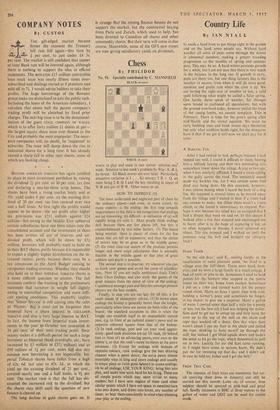Chess
By PHILIDOR
No. 91. Specially contributed by C. MANSFIELD BLACK (6 men) WHITE (8 men) WHIT! lo play and mate in two moves: solution next week. Solution to last week's problem by Way: K-R 1, no threat. All Black moves are now fatal. Particularly attractive variation is 1 . . . Kt moves; 2 B x Q, set mate being 2 R-Q 3 and the key resulting in unpin of W B and pin of W R. Other mates as set.
HOW TO IMPROVE (5) The most underrated and neglected part of chess by the ordinary player—and even, to some extent, by many experts—is the ending: the first step towards improvement in this field is the recognition that endings are (a) interesting, (b) difficult—a realisation of (a) will rapidly bring (b) with it. Most people think endings dull because there are few pieces left, but this is counterbalanced by two other factors. (I) The board being emptier, there is plenty of room for the few pieces that are left to manoeuvre, and thus the choice of moves may be as great as in the middle game; (2) the more clear-cut nature of the position permits longer and more exact calculation than is normally feasible in the middle game so that play of great subtlety and depth is possible.
The second step is to practise; try whenever you can to finish your games and avoid the curse of adjudica- tion. Next (if you are really ambitious) study Fine's Basic Chess Endings, and also study the games of the great masters from the point of view of the ending; Capablanca amongst past and Stuyslov amongst present players are the best models.
Finally, in case you are too lazy for all this, a few small pieces of elementary advice. (I) In minor piece endings the bishop is generally better than the knight, particularly when there are pawns on both sides of the board; the standard exception to this is when the knight can establish itself in an unassailable central post, e.g. in front of an isolated queen's pawn and on opposite coloured square from that of the bishop. (2) In rook endings, post and use your rook aggres- sively;.good rook positions are (a) 7th rank, (b) behind (not in front of) an advancing pawn your own or the enemy's, so that the rook's scope increases as the pawn advances. (3) Except for endings with bishops of opposite colours, rook endings give the best drawing chances when a pawn down; the extra pawn almost invariably wins in king and pawn endings and usually in minor piece or (with great labour) in queen endings. (4) In all endings, USE YOUR KING; bring him into play, and make him work hard for his living, These arc all simple points which may seem trivial to many readers; but I have seen neglect, of them (and other similar points which I have not space to mention) turn wins into draws, and draws into losses, any number of times; so bear them consciously in mind when planning your play in amending..


































 Previous page
Previous page